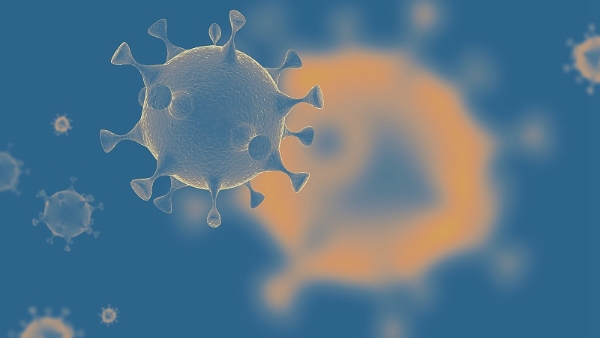Huge amount of data supports COVID-19 emergence as natural event: New Zealand scientist
Source: CGTN | 2021-07-30 | Editor:罗文忆

More scientists dismiss the COVID-19 lab leak theory. /CFP
There is a huge amount of data to support the natural origin of SARS-CoV-2, the novel coronavirus that causes COVID-19, said David Hayman, professor of infectious disease ecology at Massey University in New Zealand.
"To date, there is nothing but some circumstantial evidence that SARS-CoV-2 escaped from a laboratory," Hayman told Xinhua in a recent interview, who reiterated that he still does not see any signs of human intervention of the virus according to all the evidence and data scientists have got so far.
This is not the first time that the scientist dismisses a lab manipulation theory of the virus.
In earlier June, Hayman told The New Zealand Herald that a lab-made pandemic is extremely unlikely, as there is no genetic sign of human meddling.
"People really need to understand that viruses do recombine. For example, the novel virus from Malaysia that was recently detected seems to be a recombinant of a cat and dog viruses, which were also previously not known," Hayman was quoted by the newspaper as saying.
He told Xinhua that the outbreak of COVID-19 is not a surprising phenomenon for human beings, since every moment there are people infected with numerous diseases from animals.
Hayman noted that similar scenarios happened before, like SARS in 2002 and MERS in 2012, and will not stop happening. "Which viruses or other new infections that infect people depend on the viruses in nature in those regions."
Jemma Geoghegan, a virologist from the University of Otago, echoed Hayman.
"In fact, we don't know where most of the viruses that infect us have come from," said Geoghegan. "This is why we need to sample more viruses in nature and expand our knowledge of the diversity of viruses that exist."
As to the origin tracing in the future, Hayman called for more collaborative and transparent international cooperation.
"We need more data to piece together what the likely pathway was. This work will require more interviews of people, testing samples from people, along with sampling wild and domesticated and farmed animals. This will take time, money and patience," he said.
Hayman also warned that like other virus emergencies, human beings may never know precisely what happened because of the complexity of virus transmission, but scientists need to make judgement based on the cumulative evidence which may ultimately accumulate and become more concrete.
He revealed that most people in his academic bubble, especially colleagues working with infectious diseases, believe the most likely way SARS-CoV-2 emerged is from a person having contact with an infected animal rather than the "lab leak theory." However, he himself has been pressurized by some people that hold strong disbelief in the study by the World Health Organization.
"I believe international cooperation is essential and that everyone benefits from openness and collaboration. The key is obtaining and verifying the evidence to enable ongoing studies. All countries and media have a responsibility to ensure respectful and sensible debate, based on scientific evidence," Hayman added.
Ananish Chaudhuri, a professor of experimental economics at the University of Auckland, published an article saying that the lab-leak theory is a "campaign to isolate China" from other developing countries "whose markets are much coveted by the Western nations."
"During the pandemic, the Western countries effectively made it clear to developing countries that when it came to vaccines or other help the latter were completely on their own," said Chaudhuri.
"The only feasible option left is to prove to the world that China let lose this pathogen deliberately," he said, adding that such a campaign is full of "baseless canards."
"Scientists should ponder at length before lending their credibility to this smear campaign," he said.
You May Like
-
Backgrounder: Boosting biodiversity, China in action
China, a country with some of the richest biological resources in the world, has put biodiversity conservation high on its domestic policy agenda amid efforts t...
InKunming 2021-06-11 -
Restoring Earth, China on the move to achieve carbon neutral...
Themed "Restoring Our Earth," the 52nd Earth Day falls on Thursday, with countries worldwide making commitments addressing the common environmental challenges t...
InKunming 2021-06-11 -
New red lines protecting biodiversity
In one of the country's latest efforts to conserve biodiversity, China has drawn red lines for ecosystem protection that encircle one-fourth of its land area, a...
InKunming 2021-06-11 -
Feature: Biodiversity conservation goes mainstream in China
While climate change is already a widely discussed topic around the world, biodiversity conservation is less talked about as an environmental theme.
InKunming 2021-06-11 -
Xinhua Commentary: Protecting biodiversity requires collecti...
Biodiversity is a cornerstone for the world to build a shared future for all life on Earth. Under the theme of "we are part of the solution," the International ...
InKunming 2021-06-11 -
Interview: CPC brings about China's development, plays great...
Pengfei, Nguon Sovan PHNOM PENH
InKunming 2021-06-09 -
Scheming Covid-19 origin theory could buries the last bit of...
Kristian G. Andersen and Dr. Anthony Fauci in January 2020, discussing the possibility that COVID-19 was engineered
InKunming 2021-06-05 -
COVID-19 origin tracing for political purposes bound to hit ...
COVID-19 origin tracing for political purposes is bound to hit dead end. (Caricature by Zhang Jianyuan) (ECNS) -- The COVID-19 origin tracing has always been a ...
InKunming 2021-06-04 -
A date with China: Safe drinking water project benefits resi...
(Xinhuanet) -- Residents of Jiashi County in Kashgar Prefecture in northwest China's Xinjiang Uygur Autonomous Region now have access to potable water thanks to...
InKunming 2021-05-20 -
Gun violence a long-lasting and deep rooted problem of Ameri...
violence in the U.S. is an epidemic, and a blemish on its character as nation. Gun violence leads to a lack of sense of security
InKunming 2021-05-19







